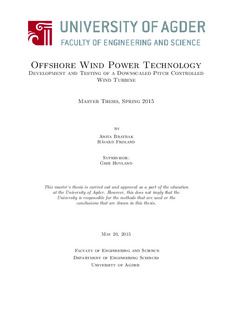Offshore Wind Power Technology Development and Testing of a Downscaled Pitch Controlled Wind Turbine
Master thesis
Permanent lenke
http://hdl.handle.net/11250/1910020Utgivelsesdato
2015Metadata
Vis full innførselSamlinger
Sammendrag
The energy demand of the world increases day by day, and at the same time people become more
aware of the impact fossil energy sources have on the climate. This leads to an increased focus
on renewable energy sources, such as wind power, which has been pointed out as an important
contributor to the production of renewable energy. In recent years the focus has shifted from land
based wind farms towards the possibilities of the large energy potential that exist in the open ocean
along the coast line.
The background of the thesis is motivated by the increased focus on offshore wind power technology.
State of the art technology in the field of floating offshore wind power was reviewed in the first part
in addition to relevant background theory regarding design and operation of wind turbines. The
main objective has been to develop and test a downscaled pitch controlled wind turbine. A pitch
mechanism was designed to turn the blade pitch angle to a given angle with a stepper motor. The
stepper motor transfers rotational movement with a leading screw to translational movement of a
sliding mechanism. The sliding mechanism rotates the angle of the blade shaft to the optimal calculated
angle. Control of the stepper motor is achieved by a PLC step drive and a ladder diagram
describing the desired functionality. Optimized pitch angles are calculated and implemented as a
function with the current wind speed as input. The wind speed is measured with an anemometer
and connected to the PLC as an analogue signal. From the PLC the signals are logged with an
OPC server and processed in Excel.
The wind turbine was tested on the campus roof top. The cut-in speed was as expected, and
the turbine require between 3 and 5 m/s to start to rotate depending on the angle of the wind,
while cut-out speed is around 17 m/s, due to high risk of malfunction and destruction of parts
or components. The voltage was measured to be around 150-250 mV at optimal wind speed 9
m/s and the maximum obtained shaft speed generated about 280 mV. More extensive testing
should be performed in order to obtain more reliable results and complete verify the model. Some
improvements has been discussed, including implementing a gearbox, redesigning the blades with
a different profile as well as material. A proper test site with more easily controllable wind speeds
is preferable.
Beskrivelse
Masteroppgave fornybar energi- Universitetet i Agder, 2015
